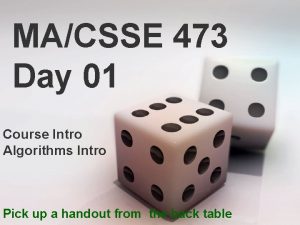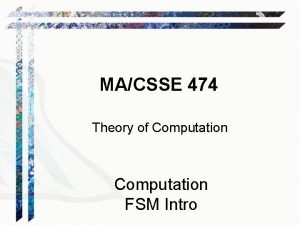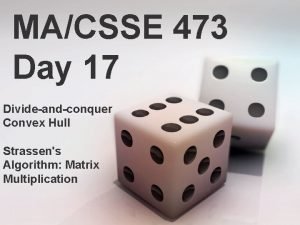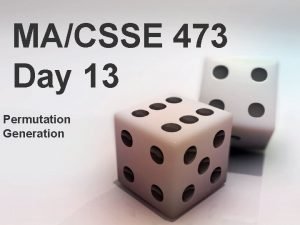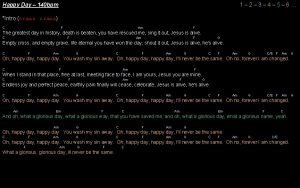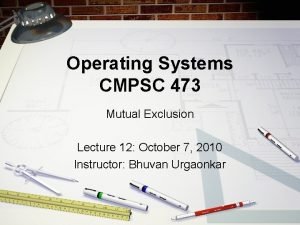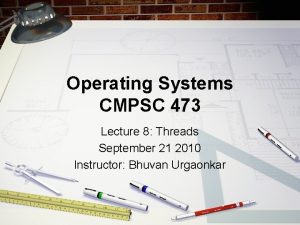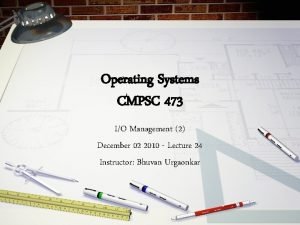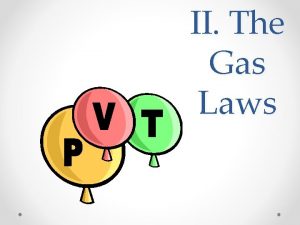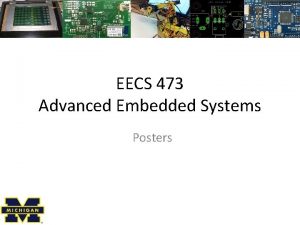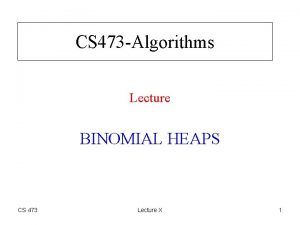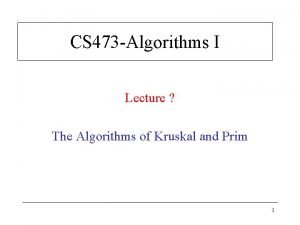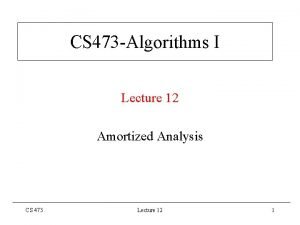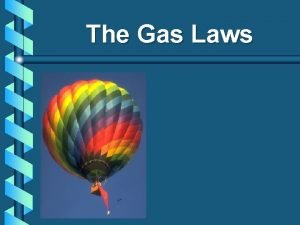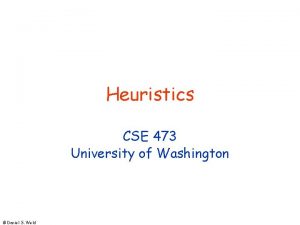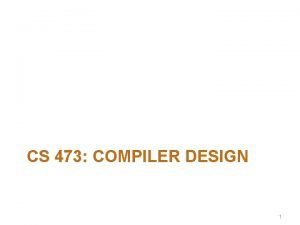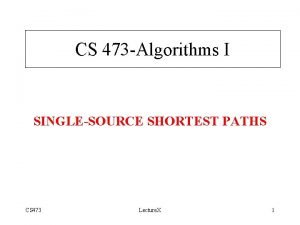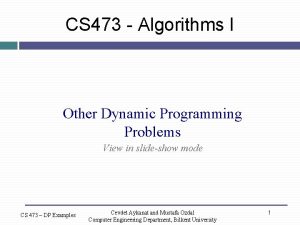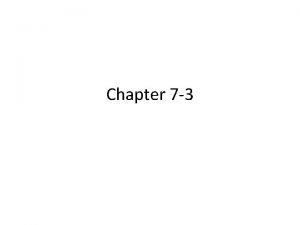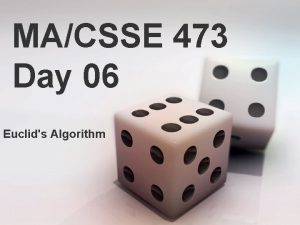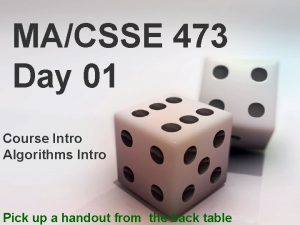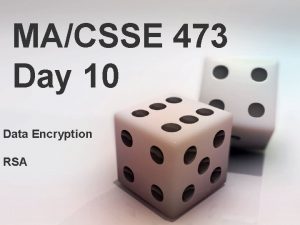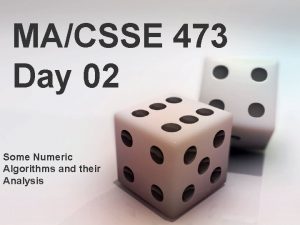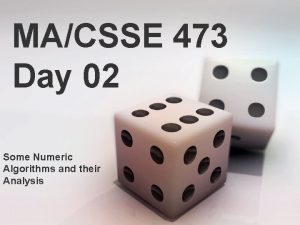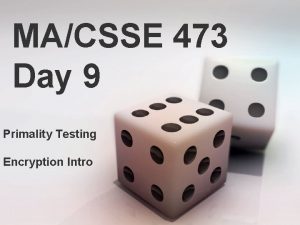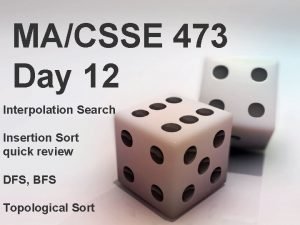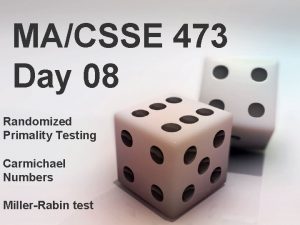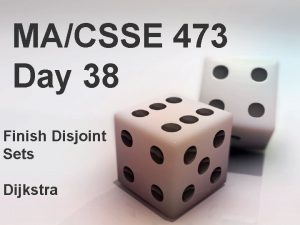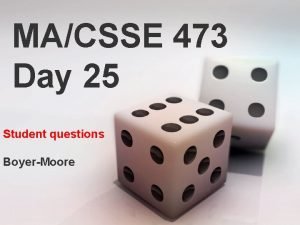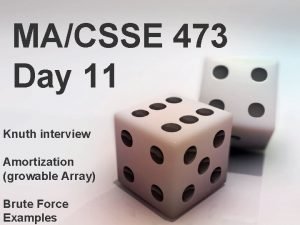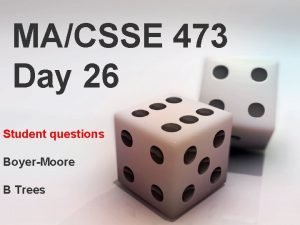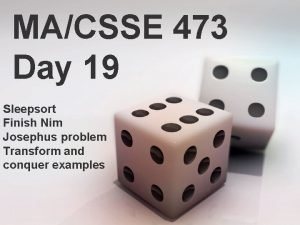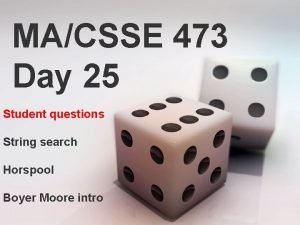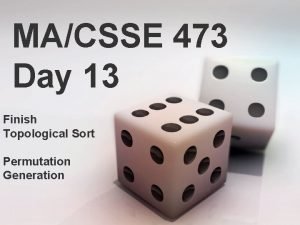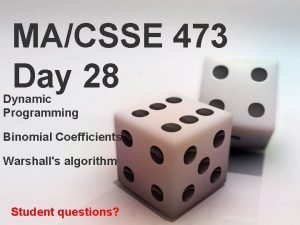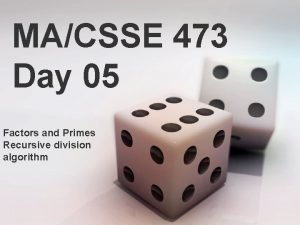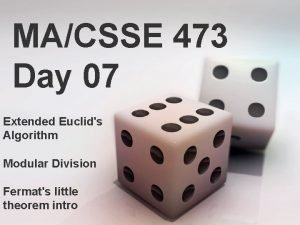MACSSE 473 Day 01 Course Intro Algorithms Intro






















- Slides: 22

MA/CSSE 473 Day 01 Course Intro Algorithms Intro Pick up a handout from the back table

MA/CSSE 473 Day 01 • • • In-class Quizzes (NOT) Roll Call/Instructor quick intro Questions about the Syllabus? The importance of Data Structures The importance of Algorithms Begin Algorithm Overview/Review – Which will last a few days

No in-class quizzes in 473 • By now, you know whether they help you. • Many days, a “handout with fill-ins” instead. • You will not usually need to have your computer in class. • But if you want to follow along with the slides… • Be careful about distractions!

Attendance sheet • Please write the name you want me and other students to call you

A Few Claude Facts • Degrees: Caltech, Illinois, Indiana (MA, CS) • This is my 29 th year at Rose • Have taught about 22 different courses; favorites are … • I have 9 children, ages 14 -35) 9 grandchildren. • I live very close to campus • In 2010 I was diagnosed with a very rare connective tissue disease, scleromyxedema. 2 -day infusions. • Despite ugly prognosis, I still know that God's in control. • I really like it when you put 473 as part of the subject line in your email to me.

Contact Info • Claude Anderson, F-210, x 8331 • anderson@rose-hulman. edu • http: //exchange. rosehulman. edu/owa/calendar/anderson@rosehulman. edu/Calendar/calendar. html. "View by week" is probably best • If you email me, please include 473 somewhere in the subject line (also include a real subject)

Where to find course materials • • Moodle: drop boxes, solutions, etc. Piazza: Announcements and discussions. Schedule page and things linked from it Notice the Hints to Exercises section that begins on p 497 of the textbook – First try to do each problem without using the hint. – But if you get stuck, by all means look at the hint. • Sometimes I will post my Power. Point slides after lectures, because they may contain spoilers. When I do post them before, I may repost a different version after. • Sometimes my slides contain more than we actually get to in class. When that happens, I will usually move that material to the following day's class.

Questions about the Syllabus? • … or the schedule page? • … or other course details? • You can ask now, or ask tomorrow

One detail before the course intro • CSSE 230 previously discussed graph implementations • So HW 1 has a problem to "review" this. • For some of you, it won't be review • So we take 5 minutes to show two representations now.

Graph representations Graph Vertex Edge Endpoints Adjacent Digraph Head, Tail Cycle, Loop Complete Connected

The Ideal and the Real • Ideal – Everyone comes to this course with the material from CSSE 230 and MA 375 fresh in their minds • Real – Only about 50% of you took 230 within the last year. • We’ll do quite a bit of review/reinforcement in this course – In many cases, you’ll understand things much better the second time you see them. • Several of the early reading assignments discuss things you have probably seen before – Sometimes treated at a higher level than what you saw before.

The Ideal and the Real, part 2 • Ideal – Everyone comes to this course with the same background • Real – You have taken a variety of courses that introduce common algorithms – Not all versions of CSSE 230 and the Disco courses are the same – And some people have taken Graph Theory, crypto, … • Result – For every algorithm we discuss, chances are good that someone in the class will have already seen it • What to do about it? – Live with it, or only discuss obscure algorithms? I choose the former

This is a very mathematical class • More about ideas than implementations • But there will be some implementation projects • An occasional “regular” homework problem will require a small implementation (usually 50 lines of code or fewer)

An approach to this course • Examine and/or analyze lots of algorithms. • Look for similar approaches. • Develop a toolbox. – Some might call it a "bag of tricks" • Internalize the common terminology and ways of talking about algorithms.

Ways of organizing algorithms • By area of application (230 approach), e. g. – Sorting algorithms – Search algorithms – Algorithms based on what data structure is used • Tree algorithms • Graph algorithms • Heap algorithms • By techniques used (473 approach), e. g. – Brute Force – Greedy – Decrease and Conquer – Divide and Conquer – Dynamic Programming

Structuring Data Can Help a Lot • If you have seen this problem before, please don’t speak up (so other students get a chance to think about it). • Example is here. (Note: I am not putting the example on-line)

Algorithms are Important • The next few slides are based on Chapter 0 of Algorithms by Dasgupta, Papadimitriou, and Vazirani (Mc. Graw-Hill, 2008) • Two enterprises have fueled the computer revolution: – Rapidly-increasing hardware speeds – Efficient Algorithms

A Big Idea That Changed the World • Moveable type – Gutenberg, 1448 (I saw a Gutenberg Bible in summer 2008 at the Library of Congress) – According to Dasgupta, et. al • • • Literacy spread The Dark Ages ended The human intellect was liberated Science and technology triumphed The Industrial Revolution happened Many historians say we owe all of this to typography – For a great discussion of algorithms and typography • See the interview with Donald Knuth in July-August CACM • It’s assigned reading for this course. See Day 11 in schedule.

The Other Earth-Shaking Big Idea • Algorithms • First step: Replacing Roman Numerals by decimals (India, 7 th century AD) – Could now do arithmetic efficiently – Codified by Al Khwarizimi (Baghdad, 9 th cent. ) • Add, subtract, multiply, divide, square roots, digits of π. • Precise, unambiguous, mechanical instructoins • The word algorithm is derived from his name. • The champion of algorithms in the West – Leonardo of Pisa (a. k. a. Fibonacci) (early 13 th century)

Do you agree with Dasgupta? • Are moveable type and algorithms the biggest change motivators since the Dark Ages? • What else would you include in the list?

Brainstorm • What is an algorithm? • In groups of three, try to come up with a good definition. • Goal: Short but complete • Two minutes

Write an algorithm … • … based on the schedule page for this course • Input: A session number (1. . 40) • Output: A number representing the day of the week. 0 represents M, 1 T, 2 R, 3 F. • Write the algorithm (a function, actually) with your group.
 Day 1 day 2 day 3 day 4
Day 1 day 2 day 3 day 4 Macsse
Macsse Macsse
Macsse Strassens algorithm
Strassens algorithm Macsse
Macsse Day 1 day 2 day 817
Day 1 day 2 day 817 Market profile day types
Market profile day types Oh happy day bpm
Oh happy day bpm Cmpsc 473
Cmpsc 473 Cmpsc 473
Cmpsc 473 Cmpsc 473
Cmpsc 473 What is k in boyle's law
What is k in boyle's law Eecs 473
Eecs 473 Cs 473
Cs 473 Kruskal algorithm in c
Kruskal algorithm in c Cs 473
Cs 473 Characteristics of gases
Characteristics of gases 75 nearest 10
75 nearest 10 Uw cse 473
Uw cse 473 Static single assignment in compiler design
Static single assignment in compiler design Cs 473
Cs 473 Bilkent cs473
Bilkent cs473 Pv=k boyle's law
Pv=k boyle's law

